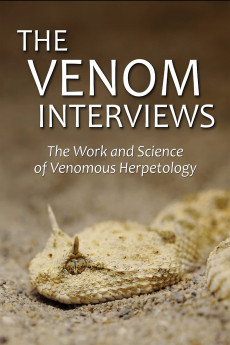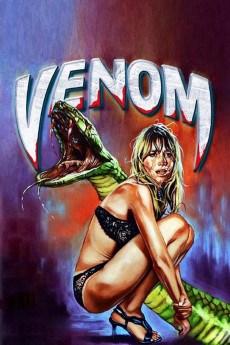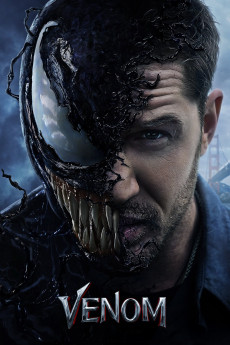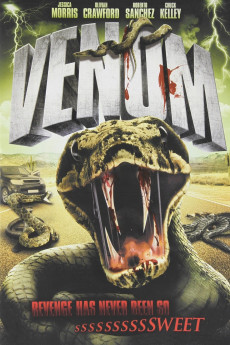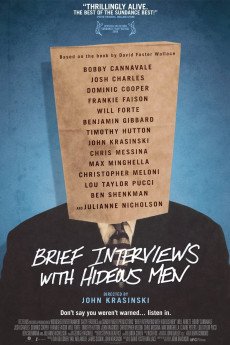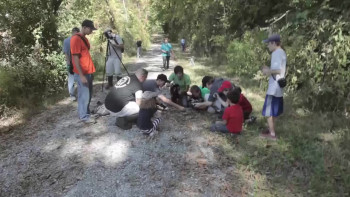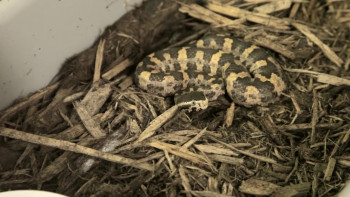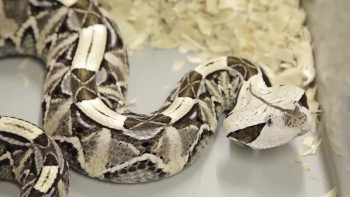The Venom Interviews (2016)
2016
Action / Documentary
The Venom Interviews (2016)
2016
Action / Documentary
The Venom Interviews (2016) Synopsis
The Venom Interviews is organized into book-like chapters, each dealing with a specific subject, following the participants from their young, pre-professional lives through their careers, and concluding with their personal retrospectives. The chapters become increasingly science-focused as the film develops.The film opens with William Becker (Central States Serpentarium) describing his "multi-faceted fascination" with venomous reptiles, using a moving comparison to the creatures from Ridley Scott's "Alien."Part I ("Dinosaurs and Garter Snakes") begins with stories of childhood fascination with reptiles, often starting with an interest in dinosaurs. There is a recurring (and surprisingly consistent) theme in which the majority of interviewees cite one type of snake - garter snakes - as the first animal they saw in the wild or kept as a pet. Outdoor scenes of groups of kids and young adults were filmed on Snake Road in LaRue-Pine Hills, part of the Shawnee National Forest in southern Illinois.Part II ("Ramping Up") follows the various paths participants took to begin working with venomous snakes. In "Starting the Hard Way," Dean Ripa recounts being seriously injured as a teenager by a bite from a cottonmouth, and then going on to build a secret collection of highly venomous snakes, unbeknownst to his parents. The next chapter - "Rear-fanged Colubrids" - describes the more typical steps to working with venomous snakes, starting with less lethal rear-fanged species.In "Mentors and Starter Species," Al Coritz (Deadly Beautiful Zoological), Doug Hotle (Albuquerque Biopark), Terry Phillip (Black Hills Reptile Gardens) and others emphasize the importance of working under the supervision of an experienced mentor to develop the skills and procedures necessary to manage highly venomous species. In the US, they recommend starting with native species, such as copperheads and small rattlesnakes, for which antivenom is readily available."Why Venomous Snakes?" discusses the motives, healthy and otherwise, that various people have for working with potentially dangerous reptiles. In particular, interviewees draw a distinction between motivations that are driven by an interest in science and those driven by ego and attention-seeking.Part III focuses on "The Private Sector" - the important scientific contributions made by private keepers, outside the world of labs and zoos. In "The Value of Private Herpetology," Terry Phillip and Doug Hotle highlight the advancements made in reproductive biology, followed by "Doc Seward & The Monsters," in which retired dentist Mark Seward gives a tour of his home-based breeding and research facility, where he studies the reproductive biology of gila monsters.The chapter "What Makes a Responsible Keeper?" advocates for the freedom of private individuals to keep venomous reptiles. Carl Barden (Medtoxin Venom Labs) and Dr. Leslie Boyer (University of Arizona) help define what responsible keeping means, including secure caging, protecting the community, and stocking antivenom for exotic species. In the next chapter - "Regulation and Permits" - Al Coritz voices the herpetoculture community's disdain for poorly-conceived, arbitrary restrictions, and cites Florida's licensing program as an example of reasonable regulation.Part IV - "The State of Television" - lays out the core purpose of the film, which is to call out the media's excessive sensationalization of venomous reptiles and the people who work with them. Al Coritz cites the work of David Attenborough and Mark O'Shea as examples of modern wildlife programming done right, while Jim Harrison (Kentucky Reptile Zoo) and Doug Hotle describe their own experiences pushing back against embarrassing attempts by filmmakers to fictionalize the subject.Part V - "Putting Risk in Perspective" - attempts to distinguish the actual risks posed by venomous reptiles from irrational, fear-driven popular imagination. In "Developed vs. Developing Countries," Carl Barden describes the difference between snakebite in Africa and South Asia, where it is still a legitimate public health problem, and developed places like the US, Australia and Europe, where fatalities are now extremely rare.Starting at this point, the film begins to focus mostly on details of the sciences around venom, envenomation and antivenom. The chapter "Dangerous, or just Toxic?" makes the case that venom toxicity is a poor indicator of how dangerous a snake may be, and in "Risks By Species," Terry Phillip and Doug Hotle explain the different factors that make various species more or less difficult to work with."Venom Control and Baby Snakes" takes on the popular myth that baby snakes are more dangerous than adults. Dr. Bill Hayes (Loma Linda University) explains some of the extensive research on this subject, the universal ability of snakes to control venom delivery, and how the myth originated and propagated.Part VI ("An Ounce of Prevention") deals with preventing accidents. In "Not a Matter of When," Jeffrey Fobb (Venom One) argues that snakebite in not an inevitable risk and that it's possible to prevent it altogether with well thought out handling protocols. That discussion is balanced in the following chapter, "Perfect, All Day, Every Day," by Jim Harrison, Dean Ripa and Doug Hotle enumerating all the things that have to go right to avoid accidents. They draw particular attention to the dangers of complacency and distraction.Carl Barden, a former pilot, explains in "A Chain of Events" the interesting parallels between airlines' approach to safety and how that relates to venomous reptile work. He compares the pattern of "chains of events" that lead to aircraft accidents to a similar pattern working with venomous snakes, in which bite incidents are the result of multiple factors.Beginning with Part VII, the film begins to explore the interesting complexity of venom and envenomation. In "A Living Experiment," Carl Barden describes the unpredictability of snakebite from the perspective of a patient and how the outcomes of bites can be surprisingly good, or surprisingly bad. This idea is then discussed from the perspective of snakebite specialist physicians in "Every Bite is Different," in which Dr. Leslie Boyer and Dr. Steven Seifert explain why the effects of envenomation vary so wildly from case to case.Jim Harrison tells the story of one of his bites in "What it's Like to be Tortured," which includes actual home video footage from immediately after the accident through his stay in the hospital. In the next chapter, "The Value of Making it Personal," Carl Barden, Denisse Abreu of Medtoxin Venom Labs and their emergency physician Dr. Stephen Knight use Denisse's coral snake bite to explain why personal relationships with their medical team are so important. "September 11" tells the everything-gone-wrong story of Lawrence Van Sertima's bite by an inland taipan in Florida on September 11, when all flights were grounded and the closest antivenom was in California. Jeffrey Fobb provides the perspective of Venom One, who negotiated the delivery of antivenom and enabled Lawrence's remarkable survival.Justin Schwartz's rattlesnake bite and subsequent surgeries, made famous by the graphic and widely-circulated photos he published) are the focus of "Fasciotomy," which addresses the controversy around surgical intervention in snakebite, a practice still favored by some emergency-room surgeons but almost universally condemned by herpetologists and snakebite specialists. Dr. Leslie Boyer, Dr. Steven Seifert, Jeffrey Fobb and Jim Harrison explain why the practice persists, the arguments against it, and the proper treatment of cases in which it is assumed to be necessary.This part concludes with "It's Complicated," a breakdown of how venoms work, the various ways in which they affect the body, and the surprising complexity of some species' venoms.Part VIII - "Once Bitten" - is all about what happens after a person is bitten. In "Who Gets Bitten, and How," Dr. Leslie Boyer and Dr. Steven Seifert present a data-based discussion of some of the misconceptions around snakebite demographics, particularly the role of alcohol as a factor, and why the popular stereotypes are only partially true. "Time is Tissue" explains the importance of preparation and rapid response, and in "First Aid?" Dr. Leslie Boyer discusses the things people should and shouldn't do in the event of a bite.In the chapter "Anaphylaxis," Carl Barden talks about his own severely allergic reactions to both venom and antivenom, and the part concludes with "Envenomation by Exotics," which presents some of the special challenges of snakebites by non-native species, particularly the difficulty of sourcing foreign antivenoms while time quickly slips away.Part IX is "All About Antivenom" - how it's made, how it works, and how it has changed over the past century. The chapter "Sticker Shock" covers the uniquely American problem of snakebite treatment routinely costing hundreds of thousands of dollars, while "Antivenom 101" is a complex but very understandable lesson in how antivenom works and how it has become more refined over time. The chapter "CroFab" examines some of the pros, cons and controversies surrounding the dominant brand of antivenom for pitviper bites in the US.The film concludes with Part X - "Now What?" - in which the participants reflect on their careers. "The To-do List" presents the interviewees' remaining aspirations, and in "The Next Generation," they talk about those who will carry on their work in the future.The final chapter, "That's a Wrap!" brings the discussion back to where it started, with reflections on those childhood fascinations, now seasoned with lifetimes of work, education and experience.The closing credits begin with a dedication to Bill Haast, whose work helped sparked the childhood interests of many of the participants, as well as some of their careers, and who passed away at the age of 100 while the film was in production. There are memorials to Bill Becker and Karel Fortyn, who passed away before the film was released. The credits are accompanied by several minutes of humorous outtakes, which contrast with the otherwise serious nature of the film.
Published Time: 2022-05-03 11:05:45

